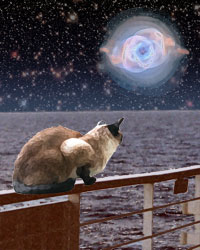
The Astrophysics Spectator
Gravitational waves are one of the features of General Relativity. They propagate at the speed of light, carrying with them energy extracted from their source. This has two observational consequences: some systems can lose substantial amounts of energy through gravitational radiation, which visibly affects how those sources behave, and these systems can be studied through the direct observation of their gravitational radiation, just as they are studied through the direct observation of the light they produce, if a means of detecting gravitational radiation can be found.
Gravitational waves are similar to their counterpart in electromagnetism. As with electromagnetic waves, gravitational waves exist because changes in the gravitational field can propagate no faster than the speed of light, and as with electromagnetic waves, the energy carried by the gravitational wave falls-off as the inverse of the distance-squared from the source of the waves.
The radical difference between gravitational waves and electromagnetic waves is the strength with which they interact with matter. Of the four forces in nature?electromagnetic, strong, weak, and gravitational?the electromagnetic force is the strongest and the gravitational force is the weakest (perhaps the middle-two forces should be called the above-average and the below-average forces). Therefore, while electromagnetic waves interact strongly with matter, gravitational waves interact almost imperceptible with mater. This means that it is difficult to create gravitational waves that carry substantial amounts of energy, and it is difficult to detect these waves, which is why they have not yet been directly detected by any experiment. On the other hand, once the waves are created, they pass through almost everything, so their detection could provide views into systems that are otherwise shrouded from sight.

A gravitational wave acts on matter as a tidal force, so a solid body would be squeezed in one direction and stretched in another, with both actions occurring perpendicular to the wave's direction of motion. A wave can be thought of as having two polarization modes, with one oriented at 90 to the other. For instance, on a Cartesian plane, one can define a polarization mode that stretches and squeezes along the x and y axes. The second polarization mode would then be along the two diagonal lines that pass through the origin of the plane.
Two approaches have been tried to directly observe gravitational radiation. The first is to measure the strain in a body caused by a gravitational wave, and the second is to measure the change in separation of suspended masses caused by a gravitational wave. Both methods have been tried without success. Currently most of the focus has been on the second method by using a device called a Michelson interferometer.
What are the experiments looking for? The short but technical answer is that they are looking for a rapidly-spinning massive object with a large quadrupole moment in its moment of inertia. In other words, they are looking for giant, spinning barbells; a spinning spheroid produces no gravitational radiation. More concretely, the experiments are looking for emission from four different sources: tightly-bound and merging binary systems of neutron stars or black holes, supernovae, spinning neutron stars, and background radiation.
The attraction of the neutron star and black hole binaries, besides being as close to barbells and one can get in astronomy, is that the binary pulsars PSR 1913+16 and PSR J0737-3039 have orbits that are decaying in the way expected if they were losing energy to gravitational radiation.[1,2] As each system loses energy, the semimajor axis of its orbit becomes smaller, and the orbital period becomes shorter. This shortening of the period is seen in the radio pulses emitted by the pulsars in the systems, providing the evidence that gravitational radiation exists. These binary-pulsar, however, is a weak source of gravitational waves. To see a binary neutron star gravitationally, one must wait until the two stars are very close together or are in the process of merging, when they are their brightest as gravitational wave sources. Because these events are rare, the detector must be able to see mergers that are in distant galaxies.
The remaining sources are far more speculative, with supernovae being the best hope. A supernova occurs when the core of a massive star collapses into a neutron star, with the resulting release of gravitational potential energy driving-off the star's outer layers. The neutron star that results from core collapse should be rapidly spinning and misshapen, which would make it a strong source of gravitational radiation. They also have the advantage of being observable from Earth, opening the possibility of observing an event simultaneously in gravitational and electromagnetic radiation. Single neutron stars are more speculative, because their strong gravity should make most of them highly spherical, which is bad for the emission of gravity waves. There is some though, however, that if they are spinning rapidly enough, and if the radius of the star is small enough, instabilities will create ripples in the star's surface that will drive gravitational radiation.
1 The binary pulsar PSR1913+16 was discovered in 1974. Hulse, R. A., and Taylor, J. H. ?Discovery of a Pulsar in a Binary.? The Astrophysical Journal 195, pt. 2 (January 1, 1974): L51?L53.
2 The binary PSR J0737-3039 was discovered in 2003. Burgay, M., et al. ?An Increased Estimate of the Merger Rate of Double Neutron Stars from Observations of a Highly Relativistic System.? Nature 426 (December 4, 2003): 531?533.
